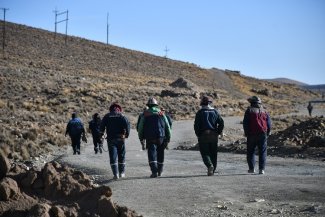Greenpeace and Wild Poland Foundation activists block the logging operations in the Bialowieza Forest, one of Europe’s last lowland natural forests, in March 2017.
As chainsaws ring out in an ancient Polish forest in defiance of international pressure, anti-logging activists are using on- and off-line means to fight back. However, authorities are standing behind the tens of thousands of foresters, who call the protesters “eco-terrorists”.
It’s yet another example of the populist, nationalist, anti-environmental policies of the government led by Jaroslaw Kaczynski’s Law and Justice party, and yet another showdown with the European Union.
Home to thousands of plant and animal species, Bialowieza is the last natural lowland forest in Europe and a UNESCO Heritage Site. Against pressure from UNESCO, the EU and others, the government is arguing that a spruce bark beetle infestation justifies cutting down as many as one thousand of the century-old spruce trees every single day.
“The aim is not to exterminate the bark beetle but to limit it, accelerating the outbreak break-down,” says Professor Jacek Hilszczański from the government’s Forest Research Institute.
During previous bark beetle outbreaks, “the cuts were done earlier, which made it easier to suppress the outbreak, but it’s never too late.” Hilszczański tells Equal Times.
Escalating confrontation
Still, opponents contend that what the government calls “indispensable sanitary loggings” are actually a cover-up for the commercial logging of old trees, not only of spruces. The Environment Ministry denies this allegation.
Environmentalists from all over Poland and the West have flocked to the Bialowieza Forest to protest the government logging, which began in May 2016.
However, the confrontation has been escalating, as ecologists chain themselves to harvester machines and hoist themselves on trees. There is a court case against seven activists.
Some of the protestors have also been met with violence. Two loggers recently beat a cameraman from Poland’s Polsat commercial TV network, destroying his camera and taking out its memory disc.
This case is also in court, with a potential sentence of up to 12 years in jail for the perpetrators. Still, chainsaw operators continue to yell at protesters, threatening to slash them with saws, according to eye-witnesses.
Protesters gained backing from the European Court of Justice (ECJ) in July this year, when it ordered Poland to suspend the logging. The Polish environment minister Jan Szyszko said the cutting would continue nevertheless. The ECJ is to review the case in September to evaluate compliance.
As with the mass protests that took place earlier this year and pressured President Andrzej Duda not to sign two of the three judicial reform bills considered to be anti-democratic, environmentalists are also turning up the heat.
In addition to protests in the forest, opponents like the Wild Poland Foundation and Greenpeace have also been on a social networking offensive. A Greenpeace page on Facebook has generated broad support, as has a petition drive called “I Love Bialowieza Forest”. As well as promoting the campaign on Twitter and Instagram, Greenpeace Poland has even commissioned a Minecraft game for the forest, promoted with a video.
Ecosystem adjustment
The head of the Bialowieza Geobotanical Station at the University of Warsaw says he believes that the government’s aggressive cutting is not necessary.
“So far the spruce bark beetle’s infestation has engulfed about 20 per cent of spruces,” says Professor Bogdan Jaroszewicz. “There is no danger that spruce trees will totally retreat from the Bialowieza Forest in the coming decades.
“From the point of view of the forest’s ecosystem the [natural] replacement of the spruce by deciduous trees is nothing bad,” he says. “The majority of the so-called ‘ecosystem services’ will be provided; the ecosystem will function normally.”
One example of this is when a beetle infestation hit Germany’s Bavarian National Park in the 1990s. The Germans, after a heated scientific debate, refrained from any logging, allowing nature to take its course. The forest recovered after 15 years.
The Bialowieza Forest straddles the Polish-Belarusian border, with 58 per cent in Belarus and the entire Belarusian share forming a protected national park. On the Polish side only 19 per cent of the forest makes up national park land. The rest is either a ‘buffer zone’ or commercial forest.
Vasil Filimonau, head forester of the Belovezhskaya Pushcha State National Park in Belarus, believes that the huge cuts that have been carried out on the Polish side are a big mistake. The Belarusians cut down the infested trees only in winter when the bugs cannot proliferate with the falling bark from logging.
Nearly 40 per cent of the entire Polish Bialowieza Forest area is covered by trees that are over 80 years old. It is home to 250 bird species and 59 mammal species, such as lynx, wolf, elk, deer, roe deer, wild boar, badger, otter, fox and racoon dogs. It is also home to the largest population of the biggest mammal on the continent – the European bison.
But the Polish government wants to change Bialowieza’s status from ‘natural heritage’ to mixed ‘human-natural heritage’, contending that “human activity in the forest is visible with the naked eye”.
While it continues to ignore the European Court ruling, Poland will be taken again to court in early September. The fines could amount to €4.25 million (US$5 million) for breaching EU law and €300,000 (US$350,000) for every day it fails to implement the ruling. Brussels is using satellite photos to check what is happening in Bialowieza.
Community divided
The local Bialowieza population is divided over the logging. Those who work for the State Forest Department are for the loggings although IKEA has banned the use of wood from the forest and the ecologists are calling other companies to follow. Those locals who live off tourism are against it since an official ban on entering the forest has been introduced.
Almost 30 per cent of Poland is covered by forests. The State Forests Department employs over 26,000 foresters, who together with wood mills’ workers, furniture and construction industry workers and almost 120,000 hunters (including many foresters) are an influential political force.
Many Polish politicians and members of parliament hunt, including the environment minister, Jan Szyszko. He is an avid supporter of logging in Bialowieza and has introduced laws allowing unbridled logging in all state-owned forests except for the national parks.
This worries Professor Jaroszewicz, who believes that the forest will lose its pristine, self-adjusting quality.
“Bialowieza Forest is unique in the scale of Poland, Europe and the world. Its species’ composition and structure are still shaped by natural processes and the natural dynamics has never been interrupted here,” he says.
“In order to last, the forest must follow environmental changes, including the very dynamic climatic changes.”










